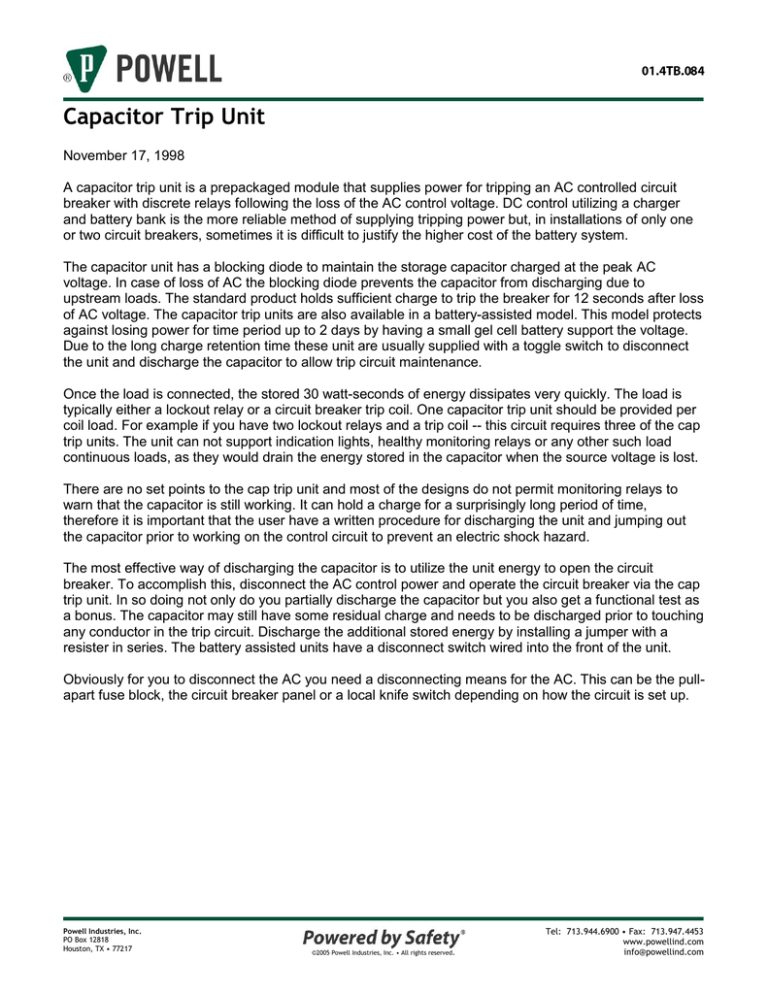
Capacitor Trip Unit
November 17, 1998
A capacitor trip unit is a prepackaged module that supplies power for tripping an AC controlled circuit
breaker with discrete relays following the loss of the AC control voltage. DC control utilizing a charger
and battery bank is the more reliable method of supplying tripping power but, in installations of only one
or two circuit breakers, sometimes it is difficult to justify the higher cost of the battery system.
The capacitor unit has a blocking diode to maintain the storage capacitor charged at the peak AC
voltage. In case of loss of AC the blocking diode prevents the capacitor from discharging due to
upstream loads. The standard product holds sufficient charge to trip the breaker for 12 seconds after loss
of AC voltage. The capacitor trip units are also available in a battery-assisted model. This model protects
against losing power for time period up to 2 days by having a small gel cell battery support the voltage.
Due to the long charge retention time these unit are usually supplied with a toggle switch to disconnect
the unit and discharge the capacitor to allow trip circuit maintenance.
Once the load is connected, the stored 30 watt-seconds of energy dissipates very quickly. The load is
typically either a lockout relay or a circuit breaker trip coil. One capacitor trip unit should be provided per
coil load. For example if you have two lockout relays and a trip coil -- this circuit requires three of the cap
trip units. The unit can not support indication lights, healthy monitoring relays or any other such load
continuous loads, as they would drain the energy stored in the capacitor when the source voltage is lost.
There are no set points to the cap trip unit and most of the designs do not permit monitoring relays to
warn that the capacitor is still working. It can hold a charge for a surprisingly long period of time,
therefore it is important that the user have a written procedure for discharging the unit and jumping out
the capacitor prior to working on the control circuit to prevent an electric shock hazard.
The most effective way of discharging the capacitor is to utilize the unit energy to open the circuit
breaker. To accomplish this, disconnect the AC control power and operate the circuit breaker via the cap
trip unit. In so doing not only do you partially discharge the capacitor but you also get a functional test as
a bonus. The capacitor may still have some residual charge and needs to be discharged prior to touching
any conductor in the trip circuit. Discharge the additional stored energy by installing a jumper with a
resister in series. The battery assisted units have a disconnect switch wired into the front of the unit.
Obviously for you to disconnect the AC you need a disconnecting means for the AC. This can be the pullapart fuse block, the circuit breaker panel or a local knife switch depending on how the circuit is set up.
Powell Industries, Inc.
PO Box 12818
Houston, TX • 77217
©2005 Powell Industries, Inc. • All rights reserved.
Tel: 713.944.6900 • Fax: 713.947.4453
www.powellind.com
info@powellind.com
Capacitor Trip Unit
page 2
If site safety requirements make it difficult for you to install the jumper on a circuit that may be in excess
of 50 volts to ground you may decide to have a push button installed to discharge the remaining
capacitor charge. I do not recommend a maintained switch, as there is too great of a chance of
energizing the circuit with the capacitor trip circuit shorted.
In closing remember there is a limited life to the battery assisted capacitor trip units. With either type of
device it is critical that you include this device into the site maintenance plan.
Jim Bowen
Technical Director
Powell Industries, Inc.
PO Box 12818
Houston, TX • 77217
©2005 Powell Industries, Inc. • All rights reserved.
Tel: 713.944.6900 • Fax: 713.947.4453
www.powellind.com
info@powellind.com



